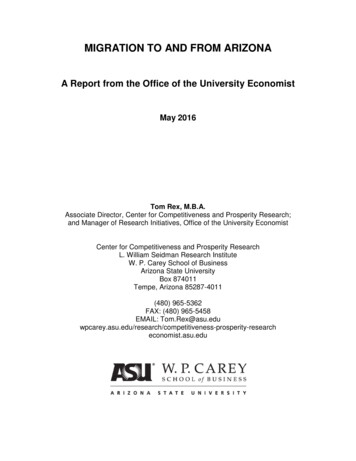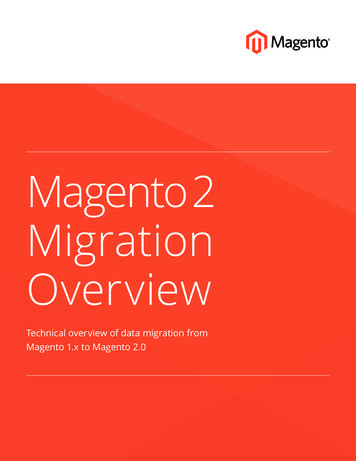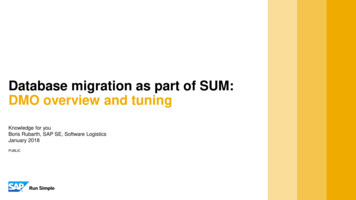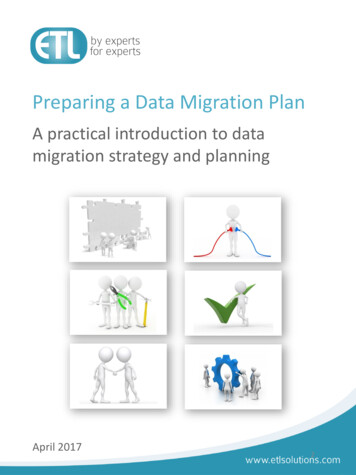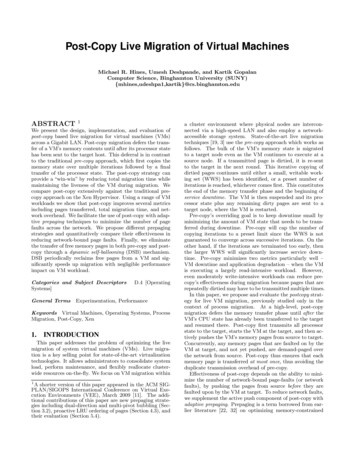
Transcription
Shutterstock/Thampitakkull JakkreeOverview of InternalMigration in Viet Nam
Shutterstock/Suriya99Viet Nam Context Viet Nam’s total population, as recorded by UNESCAP in 2016, stands at over 94 million. Viet Nam has one of the lowest annual population growth rates (1.0%) of Southeast Asia, and a totalfertility rate of 2.0 (UNESCAP 2016). Just over 34% of the Vietnamese population live in urban areas (ibid.), while the great majority of VietNam’s poor live in rural areas. This creates deep rural-urban disparities, with the average income ofurban dwellers being nearly double that of inhabitants of rural Viet Nam (UN Viet Nam 2010). Internal migrants in Viet Nam constitute a substantial population. The 2015 National Internal MigrationSurvey shows that 13.6% of the Vietnamese population are internal migrants. This proportion is higherfor the urban population (19.7%) than the rural population (13.4%) with the Southeast having thegreatest proportion of migrants, at 29.3% (General Statistics Office 2016).1 This significantly outstripsinternational migration in the country, with total inflows and outflows of international migrantsamounting to only 2.9% of the population (UNDESA 2017).1 The 2015 National Internal Migration Study defines internal migrants as persons who have moved from onedistrict to another in the five years prior to the survey and who meet one of the following conditions: have lived intheir current place of residence for at least one month; have lived in their current place of residence for less thanone month but intend to stay for at least another month; have lived in their current place of residence for less thanone month but within the past year have migrated from their usual place of residence to another district with theaccumulated period of time of a minimum of one month. The survey focuses on migrants and non-migrants aged15-59 and includes three migration types - in-migration, return migration, and intermittent migration.
Shutterstock/Shanti Hesse For the period 2009-2014, just under three-tenths of internal migration in Viet Nam was ruralurban, and an identical percentage was rural-rural. From 2010-2015 36.2% of migration wasrural-urban, 31.6% urban-urban, 19.6% rural-rural, and 12.6% urban-rural (General Statistics Office2016). Rural-urban migration has fuelled rapid urbanization, with the urban population growingby 3.4% per year in comparison to 0.4% in rural Viet Nam (General Statistics Office 2009). The Southeast and Central Highlands regions are the main migration destinations, and the Northand South Central Coast and the Mekong River Delta the main migration suppliers. Ho Chi MinhCity has the highest in-migration rate, and Ha Noi is predicted to be the fastest growing city inthe world (Anderson et al. 2017). Internal migration in Viet Nam is mostly intra-regional, with only Southeast having moremigrants from another region (the Mekong Delta, which supplies 33.9% of the region’s migrants,compared to 30.4% migrants who moved within the Southeast) (General Statistics Office 2016). The Hô Khâu2 registration system is less strictly enforced now than in preceding years, ashousehold registration has been delinked from access to essential services (World Bank Groupand Viet Nam Academy of Social Sciences 2016). However, migrants still face barriers to accessinglegally permissible as well as affordable services, such as public insurance and education forchildren, reduced electricity rates, and programs for poverty reduction. (Anderson et al. 2017;De Luca 2017; World Bank Group and Viet Nam Academy for Social Sciences 2016; Oxfam in VietNam 2015). Viet Nam is especially vulnerable to the effects of climate change. According to a World Bankstudy (Dasgupta et al. 2007), given a 1-meter sea-level rise, Viet Nam would be the most affecteddeveloping country in terms of population (10.8%), GDP (a 10% reduction), and wetlands inundated(28%). Almost half of the country’s agricultural area would face inundation with a 2-meter risein sea level (Warner et al. 2009). Such risks of sea-level rise and flooding may stimulate largescale population displacement across the region (Dun 2009). Climate change also exacerbatessoil degradation and waterlogging, water pollution, and overfishing, further pushing people tourban centres (Chinvanno 2003).2 The Hô Khâu registration system records and restricts changes in people’s residency by classifying householdsinto different categories. 3
Shutterstock/Jimmy TranMigrants’ Characteristics The proportion of female migrants has risen over time (Schelling et al. 2012). Women nowrepresent 52.4% of all migrants aged 15-59 (General Statistics Office 2016). Migrants are young: 85% are aged 15-39, with an average age of 29.2, though females tend tomove at slightly younger ages. They are also less likely to be married than non-migrants (ibid.). Kinh and Hoa people migrate more than other ethnic groups. Most ethnic minorities live in remoteand mountainous areas far from urban settings, which limits their migration opportunities dueto a lack of information and high migration costs (World Bank Group 2015). Most migrants (79.1%) are born in rural areas, and individuals from larger households with moreworking members tend to migrate more (General Statistics Office 2016). Migrants, especially rural-urban migrants, tend to be better qualified and educated than thosestaying behind. Nearly a third have professional or technical qualifications, compared to 24.5% ofnon-migrants, and just under a quarter are college/university level educated, compared to 17.4%of non-migrants (ibid.). Migrants mainly move alone (61.7%), while 31.4% move with family members (ibid.). Their socialnetworks are the primary source of assistance and information: 46.7% learn about their migrationdestination from family/friends. Very few receive information from official sources, such as jobintroduction centres or employers (ibid.). Both male and female migrants consider employment-related purposes the main reason formigration (34.7%), followed by family-related reasons (25.5%) and education (23.4%) (GeneralStatistics Office 2016; World Bank Group 2015). Men are more likely to migrate for work purposesand women for non-work purposes, such as family or study (General Statistics Office 2016).Working and Living Conditions in the New Setting Most migrants (74.8%) aged 15-59 are employed. The majority of those who are unemployedmoved for education purposes (General Statistics Office 2016). Female migrants dominantly work in the garment sector or as domestic workers, and malemigrants in the production and construction sectors or as taxi/motorbike taxi drivers. Amongboth male and female migrants the proportion employed in leadership positions is low (2.3% and0.4% respectively) (ibid.).4
Shutterstock/1tomm Only 30.9% of migrant workers have a formal written labour contract, compared to over 50% fornon-migrants. 21% have verbal agreements and nearly 10% have no labour contract at all (ibid.).This exposes migrant workers to risk of exploitation and abuse. Most migrants think they have better or much better employment (54%) or income (52%) attheir destination; just over 10% consider themselves worse off. About half consider their livingconditions and healthcare services to have improved after migration, while almost 15% aredissatisfied (ibid.) Despite a rise in migrants’ average incomes after migration, they remain lower than those ofnon-migrants. Male migrants earn more than female migrants, and migrants to Ha Noi and HoChi Minh City earn the highest mean income (ibid.). Migrant households are poorer on average than non-migrant households and spend less percapita. Migrants also have fewer savings than non-migrants, except for migrants to Ha Noi or HoChi Minh City, and are less likely than non-migrants to take out loans (ibid.). Migrants consider housing the main cause of dissatisfaction. About 30% consider that they livein worse or far worse housing conditions than they did before migration. This is mainly causedby high rent, and water and electricity charges higher than what non-migrants pay. Migrantsalso reside in areas with poor access to infrastructure, electricity, and state-provided servicessuch as public transport. Over 50% live in temporary housing or at work sites in unsafe, crampedand unhygienic conditions. 18.4% have an average living space of less than six square meters(ibid.). The proportion of migrants living in households equipped with a motorbike (88.4%), television(72.6%), refrigerator (58.5%) and washing machine (37.7%) is lower than non-migrants (96.1%,97.2%, 82.3% and 61.1%, respectively) (ibid.). Approximately 30% of migrants have found themselves facing difficulties in their new place ofresidence. This percentage is highest for female migrants and migrants to rural areas. The issuesinclude housing problems (experienced by 42%), receiving no income (38.9%), being unable tofind a job (34.3%), and being unable to adapt to a new environment (22.7%). Migrants to theCentral Highlands also report problems in relation to the unavailability of land grants (26.6%),and difficulties in access to information and water (23.9%; 14.9%). To cope with these problems,most migrants rely on their friends (40.5%) and family (32.6%) for assistance. Only a limitednumber of migrants seek assistance from organisations and unions at their workplace (ibid.). 5
Shutterstock/EmEvn Nearly 80% of those facing difficulties were aware of the problems they would face before theymoved, and 71.3% of the few that were not aware of them would still have moved if they hadbeen aware of these difficulties (ibid.). Migrants’ social isolation makes it difficult for them to make new friends and exposes femalemigrants to further risk of violence and with sexual abuse (Anderson et al. 2017). Migrants areless likely than non-migrants to participate in social and community activities due to the effortof familiarizing themselves with the new environment or the need to work night shifts (GeneralStatistics Office 2016). Loneliness and social exclusion can drive migrants, especially youngerones, to drinking gambling, petty crime, and sex work (Anderson et al. 2017). Over 70% of migrants have health insurance, a stark increase from 2004, when only 36.4%had it. This percentage rises up to 80% in the Northern Central and Mountains Areas region,and decreases to 50% in the Southeast. Most migrants without health insurance consider itunnecessary (50%) or too costly (25%) (General Statistics Office 2016). When sick, the majority of migrants attend state hospital/clinics. About 63% pay for theirtreatment themselves and only 50% use health insurance to cover their costs (ibid.). Nearly 90% of migrants are aware of unsafe sex as a cause of sexually transmitted infections.This percentage is much lower in the Southeast. Nonetheless, fewer female migrants than nonmigrants use contraceptives (37.7% versus 58.6%) (ibid.). Of the school-aged children who migrate with their parents, a significant proportion (13.4%) donot attend school (ibid.).The Impact of Internal Migration on Those Who StayBehind Most migrants remit. Over 30% of migrants sent remittances within the 12 months prior to the2015 National Internal Migration Survey. The mean remittance amount was US 1200, and themedian amount is US 530 per annum (General Statistics Office 2016). Remittances are disproportionately sent to households headed by those aged over 50, withthose aged 70 and over receiving the most (Pfau and Long 2010). Female migrants tend to remitmore, more often and in larger shares of their salaries than males. Nonetheless, the total quantityof remittances sent by male migrants is higher (General Statistics Office 2016). The Southeast, the Red River Delta and Ho Chi Minh City have the highest rates of migrantsremitting. These regions also have the highest percentages who are working (ibid.).6
Remittances are mainly used to meet daily expenses, such as food, health care and children’seducation costs, rather than production or business expansion (ibid.). An overwhelming majority of migrant-sending households (96%) consider migration to have hada positive impact on household income (World Bank 2005). Parental migration might have a negative impact on the health and school performance ofchildren left behind, especially due to a lack of supervision. The elderly and children left behindalso have to undertake more agricultural work in peak periods to compensate for the loss ofrural labour (General Statistics Office 2016; UN Viet Nam 2010). A small-scale study has suggested that internal migration modifies household structure,reversing division of labour and gender roles. Left-behind wives gain more control over thehousehold’s assets and productive work, while left-behind husbands take more domestic tasks.Nonetheless traditional roles are reassigned as soon as the migrants return (Resurreccion andVan Khanh 2007). Results from the 2011 Viet Nam Aging Survey indicate that 4.8% of those aged 60 and aboveare grandparents living in “skip-generation households” with just their grandchildren, with 2.2%living with a child aged below 10 74.1% of grandparents in “skip-generation households” findchildcare at least a small physical burden; 25.9% say it is not a burden at all, and 13% consider it aconsiderable physical burden (Knodel and Ngyuen 2015). Return migration results in both positive and negative transfers of knowledge and behaviour,including spousal transmission of HIV from returning migrants (UN Viet Nam 2010).ReferencesAnderson, K., Apland, K., Dunaiski, M. and Yarrow, E. (2017). Women in the Wind: Analysis of Migration, YouthEconomic Empowerment and Gender in Viet Nam and the Philippines. [online] Plan International. Available s/Analysis-of-Migration-YEE-and-Gender-in-Viet Namand-the-Philippines-ENG-v2.pdf.Chinvanno, S. (2003). Information for Sustainable Development in the Light of Climate Change in Mekong RiverBasin, Closing Gaps in the Digital Divide: Regional Conference on Digital GMS, Bangkok.Dasgupta et al (2007). The Impact of Sea Level Rise on Developing Countries: A Comparative Analysis. [online]Washington DC: World Bank. Available at: le/10986/7174/wps4136.pdf?sequence 1&isAllowed y 7
Shutterstock/1000 WordsDe Luca, J. (2017). Viet Nam’s Left-Behind Urban Migrants. The Diplomat. [online] Available at: http://thediplomat.com/2017/04/Viet Nams-left-behind-urban-migrants/.Dun, O. (2009). Linkages between flooding, migration and resettlement: Viet Nam case study report for EACHFOR Project. [online] Bonn, Germany: United Nations University Institute for Environment and HumanSecurity. Available at: http://ro.uow.edu.au/cgi/viewcontent.cgi?article 2409&context sspapersDuong, L., Linh, T. and Thao, N. (2011). Social protection for rural-urban migrants in Viet Nam: current situation,challenges and opportunities. CSP Research Reports. [online] University of Sussex. Available at: 8REVISE.pdf.General Statistics Office (2009). Viet Nam Population and Housing Census 2009. [online] Available at: http://www.gso.gov.vn/default en.aspx?tabid 515&idmid 5&ItemID 10799General Statistics Office (2016). The 2015 National Internal Migration Survey: Major Findings. [online] Availableat: http://Viet Nam.unfpa.org/sites/asiapacific/files/pub-pdf/PD Migration%20Booklet ENG printed%20in%202016.pdf.General Statistics Office (2012). Viet Nam Household Living Standards Survey 2012. [online] Available at: https://www.gso.gov.vn/default en.aspx?tabid 483&idmid 4&ItemID 13888.Knodel, J. and Ngyuen, M. (2015). Grandparents and grandchildren: care and support in Myanmar, Thailandand Viet Nam. Ageing and Society, [online] 35(09), pp.1960-1988. Available at: iet Nam/70A1CF1D91D1E7091A583489467F6D17.Oxfam in Viet Nam (2015). Legal and Practice Barriers for Migrant Workers in the Access to Social Protection.[online] Oxfam. Available at: e-access-to-Social-ProtectionPfau, W. and Long, G. (2010). Remittances, Living Arrangements and the Welfare of the Elderly in Viet Nam.Asian and Pacific Migration Journal, [online] 19(4). Available at: http://www.smc.org.ph/administrator/uploads/apmj pdf/APMJ2010N4ART1.pdf.Resurreccion, B. P., & Van Khanh, H. T. (2007). Able to come and go: Reproducing gender in female rural–urban migration in the Red River Delta. Population Space and Place, 13, 211–224Rushing, R. (2006). Migration and Sexual Exploitation in Viet Nam, Asia and Pacific Migration Journal, Vol.149(4) pp.471-494.United Nations Development Programme (UNDP) (2009). Human Development Report 2009 – OvercomingBarriers: Human Mobility and Development.United Nations, Department of Economic and Social Affairs (UNDESA) (2017). International Migrant Stock: The2017 Revision. [online] Available at: igration/data/estimates2/estimates17.shtml8
United Nations, Economic and Social Commission for Asia and the Pacific (UNESCAP) (2016), StatisticalDatabase. Available from .United Nations Viet Nam (2010). Internal Migration: Opportunities and Challenges for Socio-EconomicDevelopment in Viet Nam. [online] Ha Noi, Viet Nam. Available at: ency-publications/doc m.html.Warner, K., Afifi, T., Dun, O. and Stal, M. (2009). Climate Change and Migration: Reflections on Policy Needs, MEABulletin, Guest Article No. 64 [online]. Available at: www. iisd.ca/mea-1/guestarticle64.htmlWorld Bank (2005), Joint Donor Report to the Viet Nam Consultative Group Meeting, Ha Noi, December 6-7,2005.World Bank Group (2015). Migration in Viet Nam: New Evidence from Recent Surveys. Viet Nam DevelopmentEconomics Discussion Paper. [online] Ha Noi: World Bank Group, Viet Nam Country Office. Available Cuong-Vu%20Migration%20in%20Viet Nam%20Nov2015.pdf.World Bank Group and Viet Nam Academy of Social Sciences (2016). Viet Nam’s Household RegistrationSystem. Hong Duc Publishing House, Ha Noi, Viet NamThis brief is part of a series of Policy Briefs on Internal Migration in Southeast Asia jointly produced byUNESCO, UNDP, IOM, and UN-Habitat. These briefs are part of an initiative aimed at researching andresponding to internal migration in the region. The full set of briefs can be found at ternal-migration-southeast-asia 9
Viet Nam's total population, as recorded by UNESCAP in 2016, stands at over 94 million. Viet Nam has one of the lowest annual population growth rates (1.0%) of Southeast Asia, and a total

